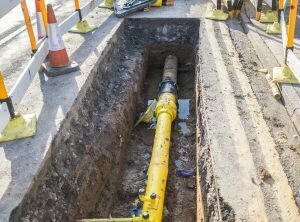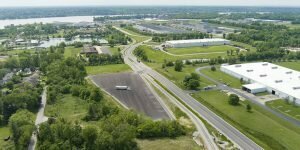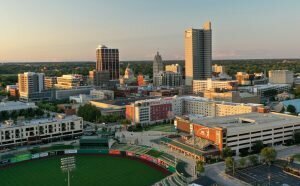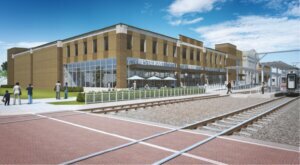This summer, the Hoosier state took the top spot in a national ranking about infrastructure. In a large CNBC study of all U.S. states, the Indiana’s roads, bridges, utilities, and other pieces of transit infrastructure scored higher than any other state.
CNBC said that Indiana is one of the states that is “leading the way” in the effort to rebuild our country’s supply chain and draw new investment from companies by leveraging our infrastructure. To form their rankings, the business news outlet measured the quality of physical transit modes, as well as major utilities like water and electric, potential sites for development, and sustainability.
All of this earned our state a total of 274 out of 380 points, which was enough to earn an A+ grade from the publication. Other facts about Indiana included:
“Carrying some 277 million tons of cargo per year, Indiana’s rail network is among the busiest in the nation. It helps the Hoosier State earn its title as the Crossroads of America. But Indiana also scores well overall for sustainability. While it lags somewhat in renewable energy, the state’s central location serves it well. Hoosiers endure less extreme weather than some of their Midwest neighbors, with low risks of wildfires or floods,” CNBC authors said.
Gov. Eric J. Holcomb said, “This No. 1 ranking affirms our approach to making strategic investments in transformative projects, our strong commitment to taking care of what we have, and our close collaboration with local communities and private partners. I’m looking forward to building on our momentum to further leverage our competitive advantage on infrastructure.”
Recent Accomplishments
Many of the recent accomplishments in Indiana infrastructure involve significantly large allocations for both maintenance and new projects. INDOT outlined some of the major developments, describing the following:
Other Big Developments
In addition to the hefty investments that have come our way, there have been lots of other big projects announced over the last several months. Each of these developments are expected to elevate our infrastructure profile and help draw more business opportunities to Indiana.
 Underground pipe being fixed in trench
Underground pipe being fixed in trench$1.2B Statewide Natural Gas System Upgrades: CenterPoint Energy Indiana North is making big moves to continue its natural gas infrastructure improvements during the next five years for 625,000 gas customers in the north central, central, and southeastern Indiana regions.
The work will primarily consist of replacing 341 miles of bare steel and cast-iron distribution mains with new mains, most of which will be plastic, as well as inspecting and upgrading transmission pipelines. Together, these efforts will call for an estimated $1.2 billion in investments.
Over the last seven years, pipeline replacement work has been ongoing in more than 50 Hoosier cities that have bare steel and cast-iron mains in the company’s north central, central, and southeastern Indiana service territory. Since 2008, more than 700 miles of gas mains have been replaced.
 $24M Enhancement to Handle More Cargo: In southern Indiana, new infrastructure improvements are expected to increase maritime commerce through domestic barge service. The Ports of Indiana-Jeffersonville celebrated the completion of a $24 million that was funded in part by a $10 million Transportation Investment Generating Economic Recovery (TIGER) grant.
$24M Enhancement to Handle More Cargo: In southern Indiana, new infrastructure improvements are expected to increase maritime commerce through domestic barge service. The Ports of Indiana-Jeffersonville celebrated the completion of a $24 million that was funded in part by a $10 million Transportation Investment Generating Economic Recovery (TIGER) grant.
The project added four miles to the port’s existing 11-mile rail network. The railyard can now accommodate 200 rail cars with the addition of enhanced train handling, a new facility that doubles the capacity of bulk commodities that get transferred from rail cars or trucks to barges, a new three-acre transload facility, two new rail loops, and more.
All of this is very important for business because the port has been busy lately. Jeffersonville’s port set a shipping record in 2021, handling 3.22 million tons, up 21.6% compared to 2020. That’s the highest annual shipment total in its history.
 $38.5M in Fort Wayne’s Record-Setting Investment: The City of Fort Wayne is making a record-setting $38.5 million in multiple neighborhood infrastructure improvements this year. Almost every area of the city is going to be seeing developments designed to enhance transportation in vehicles, on foot, and on bicycles.
$38.5M in Fort Wayne’s Record-Setting Investment: The City of Fort Wayne is making a record-setting $38.5 million in multiple neighborhood infrastructure improvements this year. Almost every area of the city is going to be seeing developments designed to enhance transportation in vehicles, on foot, and on bicycles.
$29.1 million of the funds were earmarked for roadway and bridge improvements. There will also be $6 million for various sidewalk and alleys projects, and $3.4 million for trails. This work will involve three major trail projects, four bridge projects, more than 40 miles of asphalt resurfacing, and a large array of other rehabilitation and street repair projects.
 $650M Project 10 Years in the Making: After more than a decade of public and private efforts, construction began on the double tracking of the South Shore Line this summer. In terms of the scale of work and the level of investment involved, this project is part of the biggest transportation infrastructure expansions Indiana has ever undertaken.
$650M Project 10 Years in the Making: After more than a decade of public and private efforts, construction began on the double tracking of the South Shore Line this summer. In terms of the scale of work and the level of investment involved, this project is part of the biggest transportation infrastructure expansions Indiana has ever undertaken.
Weighing in at approximately $650 million for construction, this doubling of the South Shore Line is expected to solicit hundreds of millions more dollars in investments surrounding the soon-to-be upgraded stations and properties. Funding for this project came from multiple sources, including federal, state, and local dollars.
Nearly 18 miles of new track will be added over a 26-mile corridor between Gary and Michigan City. That’s really just the start though, as numerous station, street, and pedestrian infrastructure installments will be taking place along that stretch as well. Construction is expected to finish in early 2024 with passenger service starting later in the year.
That’s Why We’re #1
All of this hard work, funding commitments, and collaborative planning endeavors make up the ingredients that earned our state the top spot for infrastructure in the country. There’s a firm philosophy that enhanced logistics equals profit and stronger companies here in Indiana, which in turn creates financially secure and promising households for all of our workers. The more we keep things moving, the better our local and international business profile will become.